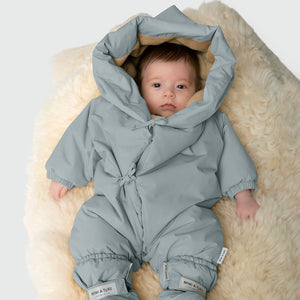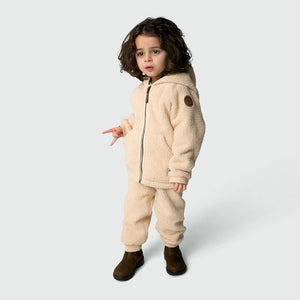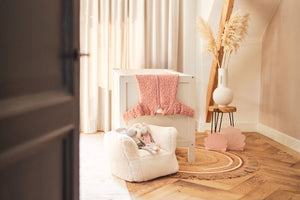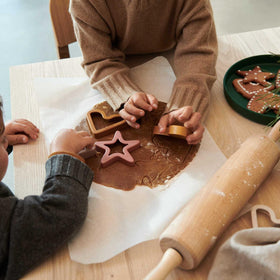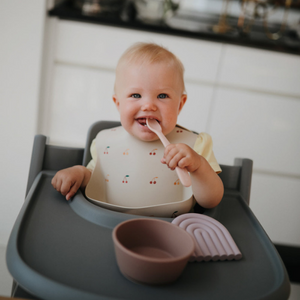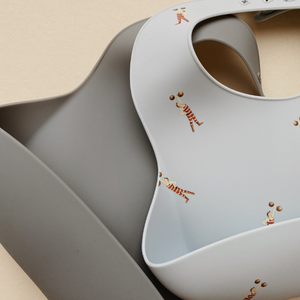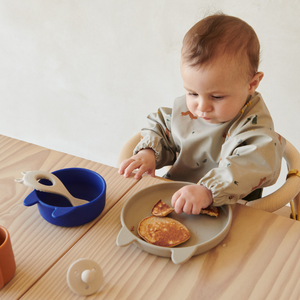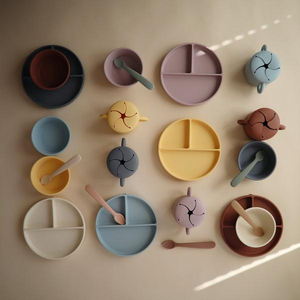
Baby's first meal: how to get the right equipment?
Among the major stages of a child's development, the introduction of solid foods is without a doubt one of the most exciting! First of all, we have to admit it, we have a lot of fun observing the reactions (and sometimes the beautiful grimaces) of baby when he discovers the tastes. Then, we set up a new organization: the meal becomes a real moment of family sharing. While some babies are enthusiastic eaters, others are less eager to try new foods. What's pretty universal is that learning to eat solid foods can be messy.
As you prepare for this important milestone, you're probably wondering what you need to make her first food experiences smooth and enjoyable. We've got the lowdown here.
Is this the right time?
Your baby will be ready to eat solid foods when she can hold her head, sit up unaided and shows interest in the food you're eating. Most babies are ready to start eating solid foods between four and six months of age. Don't hesitate to ask your pediatrician if you're not sure or have questions about the condition.
A high chair
Your baby is ready for a high chair when she can sit up unaided. This is usually around five or six months of age. When shopping for a high chair, consider your budget, the amount of space you have available, the stability of the chair (for safety) and ease of use. Make sure it is easy to clean. Some accessories, such as a removable tray or a washable, waterproof seat, can be very useful.
How much do you need?
Most families only need one high chair. If space is an issue, you can also consider a clip-on chair (which can be hung on the edge of a counter or sturdy kitchen table) or a booster seat.
Some families may choose to buy a second chair to leave with grandparents, for example, if baby eats there regularly.
Our Mealtime collection - Jourès Canada
Easy to clean mud flaps
There are many different types of bibs. As long as you have enough on hand, you can't really go wrong here. That said, your baby is going to make a lot of messes, so you want bibs that are super easy to clean and non-toxic for your child. Honestly, the Konges Slodj brand waterproof bibs with the little pocket at the bottom to catch your little.e's dropped food are invaluable. They are soft, easy to attach, easy to clean and they don't scratch. As an added bonus, they'll keep your baby looking great in any situation!
Fabric, silicone, how many of each?
If you choose waterproof bibs like the Konges Slodj brand, you'll probably only need one or two because you can clean them quickly between feedings. If you choose cloth bibs, don't hesitate to buy several (at least one or two per feeding), as they will get very messy, very quickly. A little tip: choose dark colors to hide stubborn stains like carrot or berry stains.
Silicone bibs - Pack of 2 - Konges Slodj
Baby spoons
Adult-sized spoons are too big for a baby's mouth, so investing in baby spoons is the best way to make mealtimes go smoothly. Choose soft, flexible spoons because they're easier for baby to handle and help prevent gagging. Babies do best with small amounts at first, so even if the spoon doesn't look like it holds much food, it's enough. Colorful and patterned spoons are great because they can attract your baby's attention.
Remember to check the composition. If you choose plastic cutlery, make sure it does not contain Bisphenol A (BPA), which is an endocrine disruptor that is harmful to the health of children.
How much do you need?
Invest in maybe two or three baby spoons at first. Although you can wash the spoons between or during feedings, you'll be surprised at how many spoons fall on the floor. You can also give your baby a spoon to hold and use while you feed him with another spoon. This way, your baby will feel like he or she is involved in the meal and will have a great time.
Baby bowls and plates
If you decide to cook your own baby food, it can be helpful to have some baby-sized bowls and plates for your creations. But the main reason, in our opinion, to invest in baby-specific utensils is the material. Clearly, you want unbreakable bowls and plates. And yes, with the discovery of food, also comes the discovery of gravity... baby will probably love to throw his plate on the floor and watch his parent pick it up over and over again ;)
How much do you need?
Ideally, have at least two bowls or plates available per meal. You'll probably want to introduce your child to several flavors during the same meal, so it's more convenient for you.
Cyrus Silicone Set Junior - Liewood
Baby drinking cups
As your baby begins to eat solid foods, he may also begin to take small sips of water with his meal. He's learning the art of drinking from a cup, which he'll perfect over the months.
Drinking from a sippy cup is usually easier for him than drinking from an open cup. Plus, cups minimize spills. There are many baby cups on the market. Choose one that is BPA-free and easy to clean. Most baby cups have handles that help your baby learn to manage the cup on his own.
How much do you need?
To start, you'll only need one or two cups. Your baby's cup will probably end up covered with food at least once per feeding. As your baby grows, you'll probably need a few more cups when you travel.
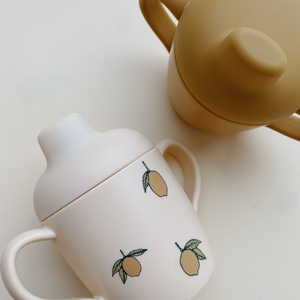
Sippy cups - Pack of 2 - Lemon
Anti-spill chair mats
Learning to eat solid foods takes time. This is normal. At first, there will be crumbs and food marks on your baby's face, hands and bib... and lots on the floor too. Especially when your baby is eating pureed foods, expect to find sticky, not-always-easy-to-clean deposits on your floor. In this case, a chair mat can be helpful. They allow for easy cleaning. How? Simply pick them up and run them under water. Some parents improvise other solutions like newspaper, but a waterproof mat is still much more practical and pretty.
How much do you need?
As a general rule, one mat will work just fine. Just run it under water after eating. Sometimes it may require more complex cleaning. In this case, feel free to have a second mat available if you wish.
"Anti-disaster" Chair Mat - Caramel - OYOY Mini
Eating is a learning experience for your baby. So give her time to experiment and expect a few messes at first. Don't worry if he doesn't like everything you serve. Also, remember that eating is a sensory experience for him. He doesn't just taste the food, but experiences it with all his senses, including his hands. When it comes to the equipment needed, the items to buy and your expectations, simplicity is often the best policy. Enjoy your meal!
Our Mealtime collection - Jourès Canada

